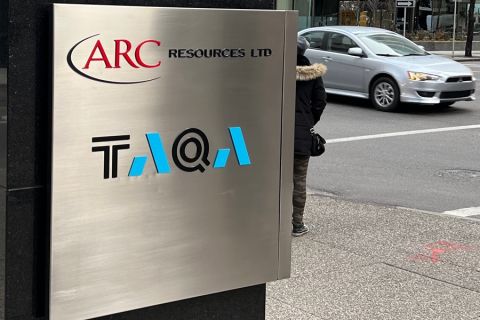Time-lapse (4-D) seismic surveys have been in use for many years and have steadily gained popularity and credibility with oil companies. Many if not all reservoirs could benefit from 4-D seismic studies to map changes due to production and to guide future development. Lack of suitable data has been the most often quoted reason for not performing such a study, conventional wisdom dictating that a useful 4-D result requires repeatable acquisition geometries and processing sequences between vintages.
With the development of dedicated 4-D processing tools and workflows, the need for
 |
|
| Figure 1a. (Top) Comparison of the NRMS progression during the 4-D processing for the reservoir interval and Balder horizon. We compare the reprocessing of the ’93 and ’02 vintages to the ’93 and ’04 “4-D-friendly” vintages using the new dedicated 4-D parallel processing sequence. Figure 1b. (Bottom) Comparison of the impact on the NRMS of reprocessing the ’93 and ’02 vintages with the updated dedicated 4-D parallel processing sequence (left) and the effect of using a dedicated 4-D acquisition (’93 and ’04 vintages on the right). In this case the updated 4-D sequence provides a more significant reduction in the overall NRMS value than the dedicated acquisition. However, both contribute to providing the best 4-D signature.(All figures courtesy of CGGVeritas) |
The case study used here is from the Foinaven field, which is part of three BP-operated fields from West of Shetlands. There were three vintages of survey at the time of the study. The baseline for the field is derived from a 1993 survey. A second survey was acquired in 2002; this was not acquired as a dedicated time-lapse project but was nevertheless used to generate time-lapse results. In early 2004, a carefully planned survey was acquired to match the 1993 vintage and provide a high-quality 4-D signal. It used a dense, overlapping acquisition to provide repeatable source and receiver positions with the original vintage.
The 1993 and 2002 vintages had been previously processed using a dip moveout (DMO) style processing flow, and while BP had used these products to extract significant value from these data, further benefits were anticipated using the more advanced techniques developed since the original dedicated 4-D processing flow had been implemented. All vintages were therefore completely reprocessed with an updated dedicated 4-D parallel processing sequence using Kirchhoff prestack time imaging (PSTM) and also improved noise suppression technology.
The aim of time-lapse processing is to provide data free of noise and multiples in a consistent manner for each vintage to obtain a reliable 4-D signal. There are several key components all
 |
|
| Figure 2. Map of the NRMS value in a window around the reservoir interval at the start and at the end of the updated dedicated 4-D parallel processing sequence. Blue indicates high NRMS values and indicates poor 4-D repeatability. |
In this case study the reprocessing used a significantly more evolved time-lapse sequence which included water layer statics, bin centering regularization, simultaneous 4-D binning, Kirchhoff PSTM, geostatistical footprint removal and co-filtering techniques. All of these processes incrementally “equalize” the two vintages to deliver a superior 4-D signal when compared to the original processing.
Four-D binning is one of the new generation of time lapse-specific processes which makes simultaneous use of the two data vintages in the 4-D dataset. It is a process by which pairs of traces between two vintages are compared for each bin on a common grid with respect to navigation attributes and/or seismic repeatability. We might, for example, want to select traces which have the highest cross-correlation or the smallest change in source-receiver geometry. Whatever criterion is chosen (and in general we will make use of several), we simultaneously populate a specific bin in both surveys using traces that exhibit the greatest similarity, immediately taking a significant step in reducing acquisition differences where possible.
One of the most often-used 4-D metrics is the NRMS value which we have already mentioned. NRMS is sensitive to noise, statics, phase and amplitude differences between surveys. The lower the NRMS value, the better the repeatability between the vintages.
During any 3-D or 4-D processing sequence, we expect that every process applied will progressively improve the quality of the data and the overall similarity of the vintages, hence reducing the NRMS value. Figure 1a illustrates the behavior of the extracted average NRMS attribute as seen between the 1993 and 2002 surveys compared to that seen from the 1993 and 2004 surveys during processing. The comparisons are made on two horizons, one of which is a window around the reservoir. It is clear that each processing step results in a reduction in the NRMS value; i.e., the overall differences between the datasets are decreasing. It is interesting to note that the same trend is seen between both pairs of data — remember that only the 1993-2004 dataset pair is considered as “4-D-friendly” acquisition.
Figure 2 shows NRMS maps at the reservoir level from the start and end of the processing for each of the 4-D dataset pairs. One thing that is very apparent from these map displays is
that there are significant acquisition-related differences between the 1993 and 2002 data (the blue linear pattern seen in Figure 2a). These differences are reduced, not surprisingly, between the 1993 and 2004 surveys (Figure 2b) thanks to the planned 4-D-friendly acquisition.
The NRMS maps for the final processed data are shown in Figures 2c and 2d. As expected,
 |
|
| Figure 3. Comparison of results from the old (left) and new (right) processing sequence using an inline from the ’02 survey before generating the 4-D difference. Improvements in de-multiple, de-noise and the move from DMO to Kirchhoff PSTM in the new sequence provide a big enhancement in signal and resolution. |
The impact of the general improvements in processing technology from the original DMO sequence to the new PSTM-based sequence is shown in Figure 3. Unsurprisingly, there is a great improvement in the image quality in terms of signal content and resolution. Roughly speaking, the improvement that can be observed here in the signal quality equates to the improvement in the NRMS value due to processing seen in Figure 1b, although the impact of the simultaneous 4-D-specific processing steps will not be obvious until we examine the 4-D signal.
While it is obvious that dedicated 4-D acquisition will always provide the best results, it is important to realize that advances in dedicated 4-D processing sequences can have a very significant impact, as illustrated by this case study. There are several conclusions which can be drawn from this.
First, dedicated 4-D parallel processing will maximize the value of 4-D data. Although this will involve the expense of reprocessing original vintages in tandem with the latest survey, operators will always benefit from the latest developments in time-lapse processing.
Second, repeatable 4-D acquisition is desirable but not mandatory if time or resources are limited or if acquisition obstacles are present.
This leads us to a possible third conclusion regarding the use of legacy data for time-lapse studies. It is likely that the pre-production seismic data available for the reservoir may fall short of current 4-D-friendly acquisition criteria. Perhaps at last we are at the stage where 4-D processing has evolved sufficiently for many of these legacy datasets to play a valuable baseline role in time-lapse studies.
Recommended Reading
Gunvor Group Inks Purchase Agreement with Texas LNG Brownsville
2024-03-19 - The agreement with Texas LNG Brownsville calls for a 20-year free on-board sale and purchase agreement of 0.5 million tonnes per annum of LNG for a Gunvor Group subsidiary.
Texas LNG Export Plant Signs Additional Offtake Deal With EQT
2024-04-23 - Glenfarne Group LLC's proposed Texas LNG export plant in Brownsville has signed an additional tolling agreement with EQT Corp. to provide natural gas liquefaction services of an additional 1.5 mtpa over 20 years.
ARC Resources Adds Ex-Chevron Gas Chief to Board, Tallies Divestments
2024-02-11 - Montney Shale producer ARC Resources aims to sign up to 25% of its 1.38 Bcf/d of gas output to long-term LNG contracts for higher-priced sales overseas.
Sempra Targets Summer 2025 for Commercial Start of ECA LNG Phase 1
2024-03-06 - Sempra is targeting the summer of 2025 as the commercial operations date for its 3.25 mtpa (0.43 Bcf/d) nameplate capacity Energía Costa Azul LNG Phase 1 project, located in Ensenada in Baja California, Mexico.
NextDecade Targets Second Half of 2024 for Phase 2 FID at Rio Grande LNG
2024-03-13 - NextDecade updated its progress on Phase 1 of the Rio Grande LNG facility and said it is targeting a final investment decision on two additional trains in the second half of 2024.




